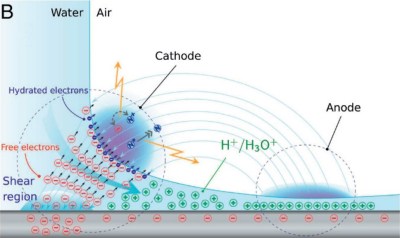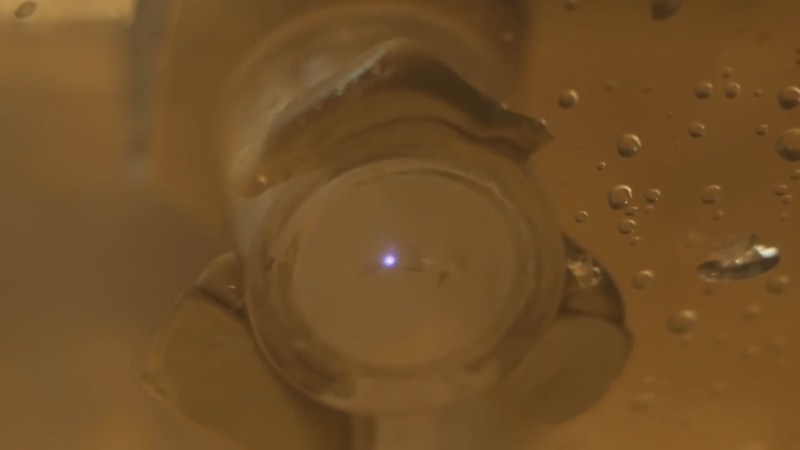When [Ben Krasnow] sees an interesting phenomenon he pursues it with a true scientist’s mentality, though it doesn’t hurt that he also has the skills and the workshop. This time he’s produced a glowing plasma by impacting fused quartz and other materials with a high-speed water jet.
The jet of pure water emerges from a 0.004″, or 100 micron, diameter sapphire orifice with a flow rate of around 2 milliliters per second giving a speed of 240 meters per second. It collides at 90° with a dielectric material where the plasma is produced as a toroid surrounding the collision point.

There’s been very little research into the phenomena but a proposal from one research paper which [Ben] found is that the plasma is a result of charging due to the triboelectric effect. This is the same effect which charges a balloon when you rub it against your hair, except that here there are water molecules running across a clear dielectric such as fused quartz. This effect results in a positively charged anode downstream of the collision while the water near the point of highest shear becomes conductive and conducts negative charge to the point of smallest curvature, producing a cathode. The electric field at the small-radius cathode acts like a short point with a high voltage on it, ionizing the air and forming the plasma. If this form of ionization sounds familiar, that’s because we’ve talked it occurring between the sharp wire and rounded foil skirt of a flying lifter.
[Ben] found support for the triboelectric theory when he substituted oil for the water. This didn’t produce any plasma, which is be expected since unlike water, oil is a non-polar molecule. However, while the researchers tried just a few dielectric materials, [Ben] had success with every transparent dielectric which he tried, including fused quartz, lithium niobate, glass, polycarbonate, and acrylic, some of which are very triboelectrically different from each other. So there’s room here for more theorizing. But check out his full video showing his equipment for producing the waterjet as well as his demonstrations and explanation.
[Ben’s] insatiable curiosity into interesting phenomenon is well know here on Hackaday. Check out his experiments into making photochromic glass and on the heat treatment of steel.
















Bens killing it again, V nice work. I was suprised by the extend he was pushing hydrolic equipment past it’s rating to that extent. what happens if the shaft does more and baloon by .5mm? explosion? ear busting shockwave? what’s the safety guidelines for working with these kinds of pressures? (sorry to be that guy. but I’m sincerely curious)
If you’re lucky, a bang and loss of pressure. If you’re unlucky, a new and exciting cutting nozzle appears at a random location and performs a piercing operation on anything between it and freedom.
I would not want to stand as close to the plumbing as Ben is.
When you are working with non-compressible liquids, you will not have an explosion or a shockwave, because the liquid will not need to expand. Depending on the size of the rupture, it will either go very far, or pour out very quickly.
When I was I child, I remember watching a digger happily working away at digging a hole in the ground, with a hole in one of its hydraulic hoses. every time the pressure flowed into that hose, a fountain of oil jetted out of said hole at a distance of roughly a metre (4ft for the non metric). There was no concern by the workers, apart from running out of oil and having less digging strength on that section of the arm.
Compressed air instead, is a completely different game to play.
modern common rail diesels run up to 2000bar fuel pressure, even a 15 odd year old common rail diesel runs 1500 bar, he estimated 1000bar for his setup. yes the pressure is scary but it’s not compressible, a leak and system pressure drops and it’s fairly harmless. imho the only real danger is injection of water I to the bloodstream if you were unlucky enough to be holding the fitting while it failed.
Ben Krasnow is a living legend.
Well, other non-conducting liquids with polar molecules, e.g various alcohols, are flammable, so definitely not suitable for any experiment involving atomisation in the air AND glowing plasma.
It is even hair-standing to hear Ben tried the experiment with oil (and “filled the shop with fine oil mist”), luckily no plasma was produced there!
On the side note, this reminded me of couple of other peculiar effects which previously captured public imagination:
https://en.wikipedia.org/wiki/Sonoluminescence – this has to do with highly agitated water too
and
https://www.technologyreview.com/s/411085/x-rays-made-with-scotch-tape/ – this one is probably also due to tribolectricity.
Hence, Ben might want to investigate further into what other effects could be detected during this experiment.
I also thought about alcohols. Yes they are flammable, so expect ignition and prepare a setup where you can deal with the fire.
Mmmmh, rather a setup where you can deal with a blast: place experiment inside a polycarbonate box filled with an inert gas.
Curious if this also gives off Bremsstrahlung x-rays, similar to how unpeeling sticky tape produces them?
http://hyperphysics.phy-astr.gsu.edu/hbase/quantum/xrayc.html#c2
If so, does it also need to be in a vacuum to do so?
Are there any materials that could withstand this impact without being fairly quickly damaged? Something akin to a transparent ceramic or a more diamond like structure? Does it even need to be see through for the effect to be “useful”?
I think that the transparency is required so that it can be picked up by the camera.
Pretty sure x-rays don’t really care about needing materials to be transparent though.
https://www.technologyreview.com/s/411085/x-rays-made-with-scotch-tape/
For them, most materials are.
Is this a possible case of sonoluminescence?
Long time reader, first time commenting.
This may tie into the aluminum oxide glass ceramic thing
Need to check the spectra of the plasma emission. If it is nitrogen excitation then his hypothesis about air discharge is likely. (see also triboluminescence, where breaking crystals create the charge and then discharge in nitrogen) If it is hydrogen, oxygen, or anything else – then we need a new hypothesis.
In the linked paper (here it is again https://authors.library.caltech.edu/83266/4/PNAS-2017-Gharib-12657-62.pdf), see the section “Optical emission spectroscopy”. When using air, they saw strong bands for nitrogen. They also show results for tests done in helium which shows bands for helium instead.
I strongly suspect that the effect equates to the water acting as a conductor, moving in a constant direction towards the dielectric, this forms what could be considered an inverse homopolar motor. Instead of the conductor rotating around the magnet or magnet around the conductor, it is effectivly constantly inverting, the water jet virtually flowing through the dielectric. The plasma forming as a result of huge current generated flowing around perpendicular to the water jet conductor.
Would this work with a paramagnetic fluid such as a magnesium salt?
– https://en.wikipedia.org/wiki/Paramagnetism#Delocalization
– https://www.youtube.com/watch?v=MUKFaxy-z7s
If you were able to add C60 Fullerenes to the water, would it possibly increase the effect? Diamond and graphene are both more diamagnetic than water.
– https://en.wikipedia.org/wiki/Diamagnetism#Materials
But the expense for that would outweigh the value of the experiment:
– https://www.sigmaaldrich.com/catalog/product/aldrich/379646